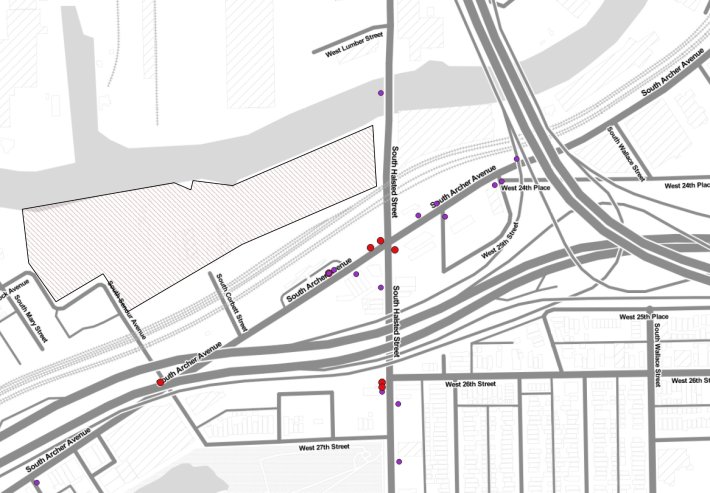Residents of Bridgeport and Chinatown are asking the Chicago Plan Commission to reject a zoning change to allow for a 112,000-square-foot Amazon warehouse in the area. The Southwest Side already has many logistics facilities, as do other parts of the South and West side. The large number of fulfillment centers and other industrial sites contributes to increased air pollution in the area and as former Streetsblog writer Lynda Lopez reported, creates challenging conditions for walking and biking.
If approved, the site would be located at 2420 S. Halsted St., west of Halsted on the south bank of the South Branch of the Chicago River, would add more heavy freight vehicles. Amazon would move into a structure building that would be developed by Prologis, a San Francisco-based real estate investment trust. According to a July 2020 Crain's Chicago report, the development would include 11 truck loading docks and 449 parking spots. One of the proposed access points would have trucks crossing the Halsted bike lanes near the Halsted Orange Line station to enter the facility.

A firm contracted by Prologis conducted a traffic impact study. The report assessed the impact of the fulfillment center on existing traffic conditions and whether any streets or access improvements are needed to accommodate the center’s needs. Ultimately the traffic study found that the center’s needs would overall be “adequately served” by existing infrastructure but that a traffic signal would be needed at Halsted at one of the access points, plus a few other small changes.
But while the study looked at the traffic congestion impacts of the new facility, it didn't discuss the potential for more traffic crashes, nor the certain increase in air pollution and other quality of life drawbacks. That makes sense, because those areas of concern are outside the scope of the consultant's work. Similar to the proposed car-centric developments next to the Harlem Blue Line stop I discussed on Streetsblog last week, and countless problematic projects in our city, the Bridgeport development highlights the flaw's in the city of Chicago's planning approval process.

According to Chicago Department of Planning and Development documents, developers for the site met with 11th Ward alderman Patrick D. Thompson in June 2019. Thompson held a public meeting in June 2020 to brief local residents and other community stakeholders about the proposed development. If constituents had been informed about the project earlier in that one-year gap, they would have had more time to organize against the project.
Now a coalition of groups are on the offense, hoping to persuade the Plan Commission to reject the zoning change. The alliance include the Active Transportation Alliance, Center for Neighborhood Technology, Neighbors for Environmental Justice, Little Village Environmental Justice Organization, Bridgeport Alliance, Chicago Asian Americans for Environmental Justice, Equiticity, Blacks in Green, and Bike Lane Uprising.
The coalition is also asking the Plan Commission place a “moratorium on all rezoning for logistics facilities on the South, Southwest, and West sides until the City Council passes ordinances that address the inequitable distribution of logistics facilities which are rapidly appearing.” In their letter to the Plan Commission they list a number of other logistics facilities in development in these parts of town.
I was particularly struck by the last line in the coalition’s letter to the Plan Commission, “Green, livable, and healthy land uses and jobs are possible and can be envisioned together.” Indeed, reforming our planning process and curbing aldermanic prerogative is part of necessary changes in order to create more equitable, sustainable, and resilient communities. Along with reining in aldermanic privilege, we must make it easier for residents to learn about proposed developments within or near their neighborhoods.
Currently you have to navigate the Plan Commission website or rely on updates from your aldermen. Each alderman has their own way of informing residents which adds another barrier or advantage, depending on that Council member's protocols. Additionally, this process only applies to proposed developments that require a zoning change -- it's even harder to find out about ones that don't. There has to be a better way, one where residents help proactively shape development plans as opposed to having to react to proposals.
If you want to share your concerns about this development, it is on the agenda for the Chicago Plan Commission’s Thursday November 19th meeting. The virtual meeting starts at 10am. Written statements are the preferred method of public comment and will be accepted up to 24 hours in advance of the meeting at CPC@cityofchicago.org. Statements are posted online for public review prior to the start of each meeting. You can access the live stream here.




